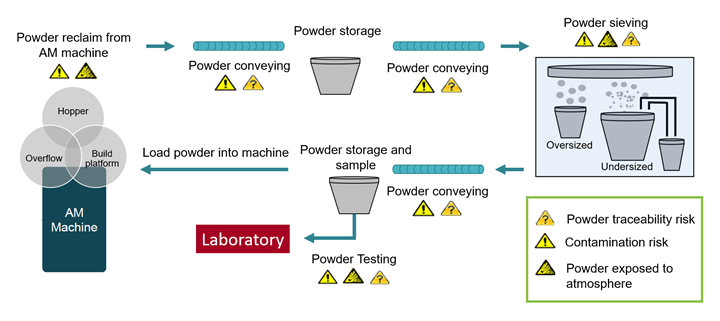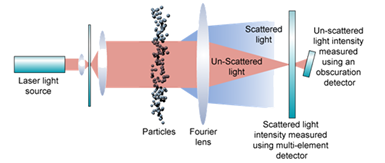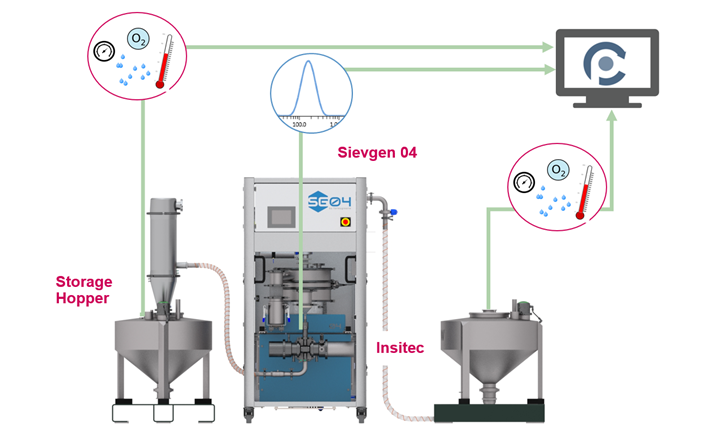Share
Read Next
“The constant challenge in additive manufacturing is that manufacturers are never sure if the powder is good enough to be reused,” says John Duffy, segment marketing manager at Malvern Panalytical. “But it’s beneficial to recycle it because it’s so expensive. You only ever use a small amount, maybe only 20% in a build.”
The remaining 80% or so of unfused powder may be perfectly reusable for many applications — the barrier to recycling is not so much the material quality as it is the ability to quickly measure and verify that quality.
Malvern Panalytical is one of several organizations that recently teamed up to prototype a solution to additive manufacturing’s powder recycling challenge. The company, which provides material analysis equipment used in a range of industries, integrated its laser diffraction tool with a sieving solution from Farleygreene and material hoppers and powder management software from Carpenter Additive. Dubbed “PowderCleanse,” the complete solution was conceived as a means of performing in-line powder inspection that can be completed during the standard powder sieving step.
Material Inspection During Sieving
The PowderCleanse workflow looks something like this: A PowderLife hopper from Carpenter Additive is connected to a Sievgen 04 sieve from Farleygreene. The powdered material is conveyed pneumatically into the sieve and processed as usual while Malvern Panalytical’s Insitec unit simultaneously measures the particle size distribution via laser diffraction; as the powder particles fall through the sieve, laser light shining through creates a distinctive scatter pattern that indicates the size of the particles.
The PowderCleanse system consists of PowderLife material hoppers and software from Carpenter Additive; a Sievgen sieve from Farleygreene; and the Insitec unit and analysis software from Malvern Panalytical. Image Credit: Malvern Panalytical
The technology allows for the detection of both fine and oversized particles that may have made it through sieving; too many of either extreme particle size might indicate something amiss in the 3D printing process that deserves attention. The primary purpose of the laser diffraction, however, is to characterize the powder properties and provide assurance that the material that passes this step is “clean” and can be trusted. Analyzed powder is then conveyed directly into a new waiting hopper, ready to be used again. The analysis step is controlled by Malvern Panalytical’s Link2 software; traceability data about the material’s oxygen content, moisture, chemical makeup and particle size distribution is recorded through Carpenter’s PowderTrace software.
While virtually all metal additive manufacturers working with powder perform some type of analysis on their materials, the distinctive feature of the PowderCleanse solution is that recycling and analysis can happen directly on the production floor. The system is fully enclosed, which protects operators as well as preventing the powder from being exposed to excess oxygen or moisture in the course of the recycling and sieving process.
It also means that powder characterization doesn't have to happen in a separate lab elsewhere in the building or possibly off-site; keeping analysis and recycling on the manufacturing floor saves time that might otherwise be wasted waiting for results. And while the sieving step was slowed in testing of the prototype to enable nearly 100% inspection of the powder, for applications requiring less than 100% inspection, users could manipulate the throughput to suit their needs.
A Modular Solution
PowderCleanse was developed as an integration project, Duffy says, with testing conducted by the Manufacturing Technology Centre (MTC) in the UK. The system was tested for its accuracy and efficacy in measuring powder, as well as various factors related to usability (including safety, ease to learn and memorability for operators). The solution was declared a success, though it has yet to be tested on a production facility floor.
“The goal was to develop a concept and prove it out,” Duffy says. While PowderCleanse is not being sold or marketed as a standalone product, “It was always meant to be modular, and each component is commercially available.” Malvern Panalytical’s integration team is available to help create customized solutions for interested clients working alongside the other project partners. Other types of analysis could be incorporated into such as system as well, for instance chemical analysis.
Related Content
How Norsk Titanium Is Scaling Up AM Production — and Employment — in New York State
New opportunities for part production via the company’s forging-like additive process are coming from the aerospace industry as well as a different sector, the semiconductor industry.
Read MoreHow Machining Makes AM Successful for Innovative 3D Manufacturing
Connections between metal 3D printing and CNC machining serve the Indiana manufacturer in many ways. One connection is customer conversations that resemble a machining job shop. Here is a look at a small company that has advanced quickly to become a thriving additive manufacturing part producer.
Read MoreVulcanForms Is Forging a New Model for Large-Scale Production (and It's More Than 3D Printing)
The MIT spinout leverages proprietary high-power laser powder bed fusion alongside machining in the context of digitized, cost-effective and “maniacally focused” production.
Read MoreBeehive Industries Is Going Big on Small-Scale Engines Made Through Additive Manufacturing
Backed by decades of experience in both aviation and additive, the company is now laser-focused on a single goal: developing, proving and scaling production of engines providing 5,000 lbs of thrust or less.
Read MoreRead Next
Profilometry-Based Indentation Plastometry (PIP) as an Alternative to Standard Tensile Testing
UK-based Plastometrex offers a benchtop testing device utilizing PIP to quickly and easily analyze the yield strength, tensile strength and uniform elongation of samples and even printed parts. The solution is particularly useful for additive manufacturing.
Read MoreCrushable Lattices: The Lightweight Structures That Will Protect an Interplanetary Payload
NASA uses laser powder bed fusion plus chemical etching to create the lattice forms engineered to keep Mars rocks safe during a crash landing on Earth.
Read MoreAlquist 3D Looks Toward a Carbon-Sequestering Future with 3D Printed Infrastructure
The Colorado startup aims to reduce the carbon footprint of new buildings, homes and city infrastructure with robotic 3D printing and a specialized geopolymer material.
Read More

.jpg;width=70;height=70;mode=crop)






















